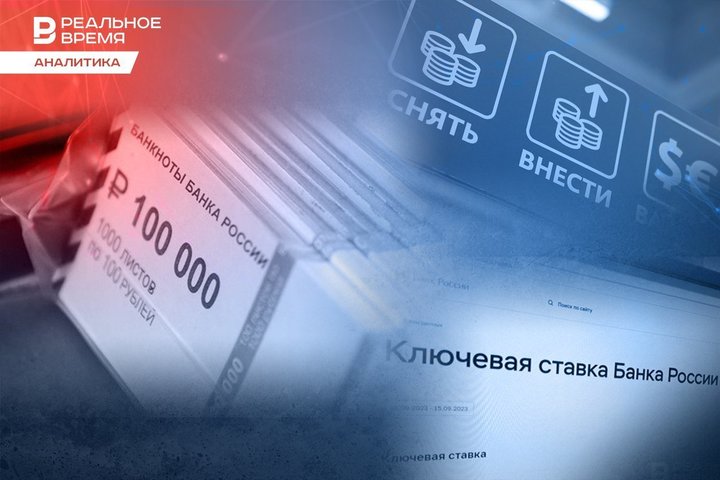Deposits going for a record
Increase in the key rate has returned money to deposits

The bank deposits of Tatarstan residents have increased by 19.1% over the year, and the savings of individual entrepreneurs — by 46.4%. At the same time, deposits of legal entities have decreased by 2.6%. All together, they currently keep almost 1.7 trillion rubles in Tatarstan banks. The largest share — 907.8 billion rubles — belongs to individuals. However, according to the Deposit Insurance Agency, today the average deposit does not exceed 350 thousand rubles, and only 1.5% of depositors in Russia keep 1-1.5 million rubles on deposit. Whether the announced increase in the insurance amount for deposits to 2.8 million rubles will change the situation on the market and what factors will affect deposits in 2024 — in the review of the analytical service of Realnoe Vremya.
Trillions at interest
The total volume of deposits of individuals in Tatarstan (excluding funds in escrow accounts) reached 907.8 billion rubles on February 1, the press service of the National Bank of Tatarstan told Realnoe Vremya. Over the year, deposits of Tatarstan residents increased by 19.1%, or by 145.8 billion rubles. At the same time, the share of ruble deposits accounted for 94.3%. Compared to the same date last year, the share of deposits in foreign currency decreased by another 3.9% to 5.7%.
Funds in the accounts of individual entrepreneurs increased by 46.4% over the year ' to 41.7 billion rubles. As of February 1, 2024, the amount of funds on deposits of legal entities in Tatarstan decreased by 2.6% compared to the same date in 2023 — to 717.2 billion rubles.
Last year, Russians deposited a record amount of money. As of December 1, there were 27.9 trillion rubles on deposits in Russia, according to data from the Central Bank. In 11 months, the indicator increased by 5.2 trillion rubles. The growth, compared with the same periods of previous years, turned out to be the highest in the entire history.
A sharp increase in the key rate from 7.5% to 16% per annum certainly played a role in the record growth of deposits. In December 2023, deposit rates reached their maximum for the year and rose to 16-18.5% per annum.
Average deposit size does not exceed 350 thousand
According to the Deposit Insurance Agency (DIA), the average deposit amount of an individual in Russia as of February 1, 2024 is 342 thousand rubles. The maximum amounts of compensation established by law of 1.4 million and 10 million rubles (for escrow accounts) provide full insurance protection for 98% of all depositors of operating banks — individuals.
Amounts up to 1 million rubles are held on deposits by 96.3% of depositors, another 1.5% — from 1 million to 1.4 million rubles.
At the same time, the Central Bank announced its readiness to double the amount of insurance for long deposits, we are talking about deposits for a period of three to five years. The regulator plans to raise the bar to 2.8 million rubles. As the deputy chairman of the Central Bank, Olga Polyakova, said in an interview with Interfax, this issue is now being addressed. She also stressed that this will increase the popularity of deposits and, as a result, will help banks attract long-term money for lending to the economy.
Legal entities launched the money into circulation

The growing interest in deposits among the population is due to attractive fixed income: deposits at 16.5-17% are represented on the market today, which is higher not only than inflation rates, but also the key rate, Shamin notes.
The expert believes that the bank deposit market will continue to grow due to high deposit rates, rising salaries and social benefits, as well as due to the gradual transition of the population to a savings model of behaviour due to high rates on consumer loans and mortgages. “In the absence of affordable loans, most of the population refuses to make large purchases, as they say, right here and now," he explains.
The key rate of the Bank of Russia, according to the February forecast of the regulator (the average annual value is 13.5-15.2%), will remain at a high level throughout 2024. Taking into account the possible reduction of the key rate in the second half of the year, the range of maximum interest rates on deposits may be reduced to 12-14%.
The initiative of the Bank of Russia to increase the insurance amount for long-term deposits should strengthen the attractiveness of “long” deposits among the population, as well as affect the increase in the average deposit amount. “This decision is positive for the population in terms of protecting the interests of those depositors who would like to place larger amounts in medium and small banks: they usually raise funds at more favourable interest rates for customers compared to the largest banks in the country," explains Shamin. “Still, as a rule, clients tend to place a deposit in the amount of up to 1.4 million rubles within the reimbursement of the Deposit Insurance Agency.”
However, in general, these changes will not be very significant for the deposit market in Russia, since the share of deposits over 1 million rubles, according to the Deposit Insurance Agency, does not exceed 3.6%, he cites as an example.
In addition, changes in deposit rates will be influenced by banks' need for liquidity and demand for loans, the level of profitability on credit products, inflationary expectations of the population and the value of the ruble relative to other currencies.
Individuals switched from spending money to saving

Rosbank's retail business portfolio totalled 384 billion rubles by the end of 2023, which was by 86% higher than in 2022 (and 3.6 times faster than the market growth rate). During the year, Rosbank attracted more than 115 thousand new depositors, which was three times higher than the results of 2022, and the amount of payments on customer cards increased by 46% to 24 billion rubles per month. By the end of 2023, the portfolio of savings of citizens in Rosbank in the Republic of Tatarstan showed an increase of 105% compared to 2022 and amounted to 8.5 billion rubles.
According to Rosbank forecasts, the trend will continue in 2024, but it is unlikely to be long-term. The interest rate will no longer be the main driver in the competition for the client's money, but will be one of the criteria for making a decision.
In 2024, Rosbank predicts maintaining double-digit growth rates of funds raised from individuals — at the level of 12-16%. Against the background of high interest rates, the deposit segment will grow faster than current balances.
“In August-October 2024, deposit agreements with high interest rates (15-16% per annum) will be completed in most banks, and it can be assumed that an interesting rivalry between banks, investment companies, developers, automakers and network retail will unfold for this money," Ruslan Yulbarisov believes.
Geopolitical situation will continue to affect depositors
The dynamics and attractiveness of deposits in 2024 will be influenced by their profitability, on which the amount of the depositor's interest income depends, and taking into account capitalisation, they can give a significant increase in the volume of deposit base for banks, says Egor Lopatin, the director of the group of ratings of financial institutions of NKR agency. Besides, the dynamics of the funding base will be influenced by the stability of the geopolitical situation, which may affect the behaviour of individual groups of depositors.

Funds of individuals in Russian banks increased by 22.1% over the year as of February 1, 2024. The main reason for the acceleration of the growth of household deposits is the increase in interest rates, says Maxim Osadchy, the head of the analytical department at BKF Bank.

Osadchy believes that the previously announced increase in the amount of deposit insurance will certainly have a positive effect. However, the main inflow of deposits, according to him, goes to state banks, for which deposit insurance is only a formality.
Deposits will remain the most understandable savings tool

Public bonds or the bonds of leading Russian issuers are also close in terms of risk/return ratio. Stocks can also be called a good option, since in the long term, the profitability of the stock market, as practice shows, outstrips the rate of inflation. “However, both stocks and bonds are still risky securities, besides, in order to work with them, you need to have certain knowledge and skills of working on the stock market," the expert notes. “Other investment options are real estate and gold. But these are rather low-liquid tools designed for a long time, so they are not suitable for everyone. In the case of real estate, the amount should also be very high.”
According to Dodonov's forecast, the key rate in the Russian Federation in 2024 will remain double-digit, therefore, deposit rates will remain elevated. In this regard, the attractiveness of bank deposits for the population is likely to remain. Although the growth of household funds in banks will slow down to 9-11% this year, the analyst believes.